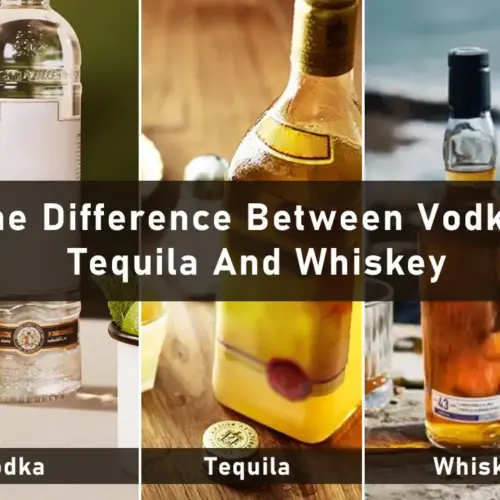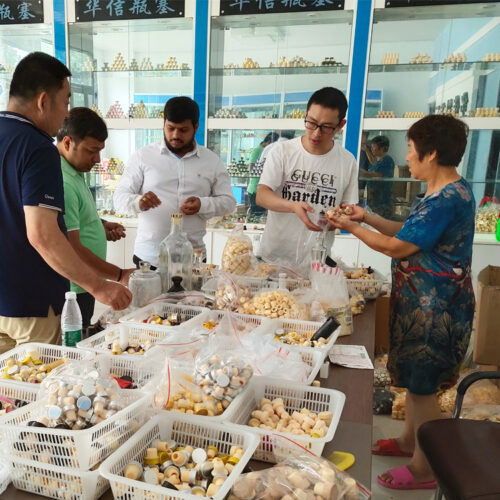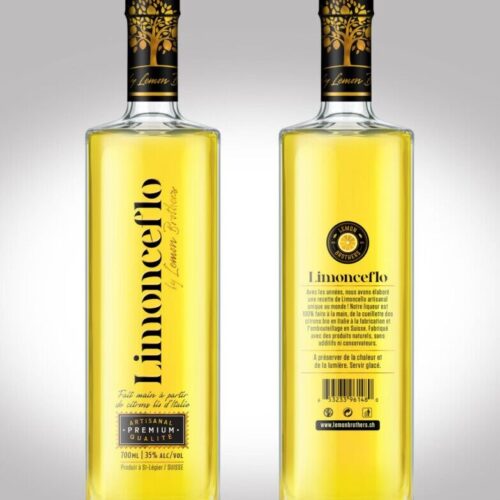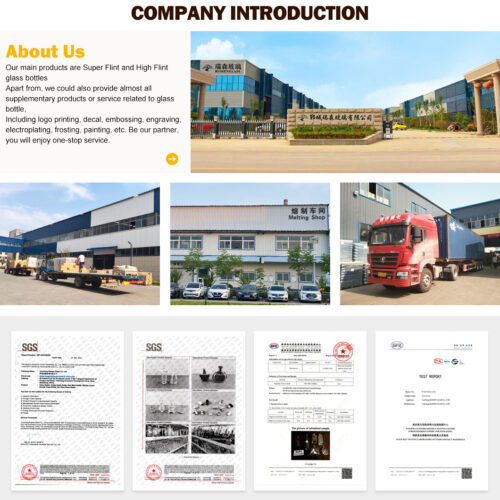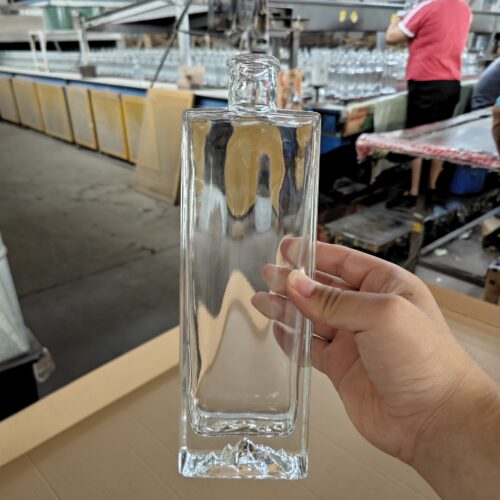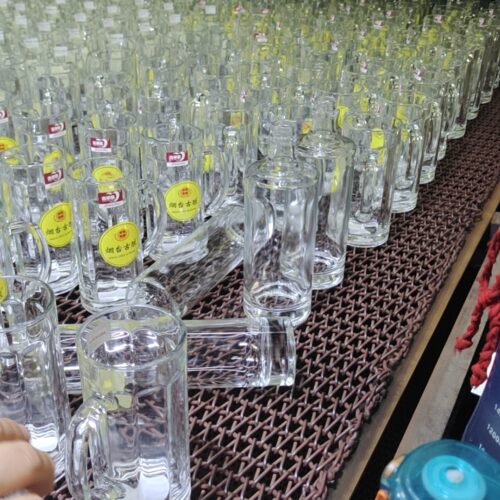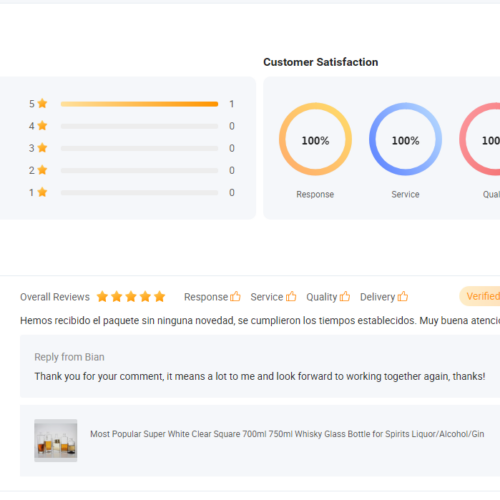- Mold inspection:
- For glass bottle manufacturers, most of them produce according to the molds provided by customers, or according to the newly opened drawings and molds of sample bottles. For the key size of the mold that will affect the forming, it is necessary to communicate and negotiate with the customer immediately when the mold is opened and reach a consensus on the modification of the key size
- When entering the factory, all molds shall be equipped with mouth molds, initial molds, and finished molds and shall be inspected according to the drawings or customer requirements.
2 Parts inspection:
- It is the first batch of 10-30 products produced before the mold withdrawal machine. Two to three products are pumped per mold for size and specification inspection: the diameter inside and outside the mouth, whether the words on the base are correct and clear, and whether the bottle body pattern is correct.
- When the bottle comes out of the quenching line, the quality control monitor will limit the product out of each mold to 2-3, and test all aspects according to the drawings. In addition to the above, capacity measurement, material weight measurement, inside and outside diameter of the mouth, filling the Chiang bottle with water if necessary, and physical assembly using the customer-supplied lid to test whether it can be covered in place and whether it leaks. And make internal pressure, internal stress, acid, and alkali resistance tests.
3 Process check:
- If the mold is not changed, extract 2 pieces of each mold every 2 hours to detect capacity and material weight. In addition, the inner and outer diameters of the orifice plates should be tested.
- Due to the mold, a new mold may need to be replaced in the process of processing. Therefore, the mold workshop should inform the quality inspection workshop immediately after the mold change.
Iv. Full Inspection:
- After the products come out of the annealing line, the quality inspection personnel shall conduct a comprehensive appearance inspection on all products, namely:
(1) Bottle bubbling: bubbling is a common problem in the production process of glass bottles, and most quality control personnel cannot correctly grasp the size. If the sealing surface of the bottle mouth is not allowed to have more than 1mm bubbles; Bottle body: Bubbles less than 1mm – no more than 6 bubbles within the square centimeter; There are no more than 3 bubbles of 1mm < 6mm, and the spacing is greater than 20mm. The surface is not allowed to burst bubbles, is difficult to grasp, and can only be compared with different shapes of film.
(2) Crooked neck: it is mainly caused by the dislocation between the mouth die and the forming die or the side of the mouth die is not completely placed on the forming die in the operation process. This can be resolved by correcting the operator’s actions. Even if it does not affect the fit of the cap, it will affect the appearance of the entire bottle.
(3) Oblique bottom: the bottom material is not uniform, and the thickness is half or even more than half, which affects the quality of the product and reduces the grade of the bottom product.
(4) The thickness of the sealing line: the surface of the sealing line is greater than 0.5mm, and it is not even allowed to have the feeling of scratching. The special sealing surface of the bottle mouth is not allowed. The main reason is that the mold is not closed in place or worn, which needs to be repaired, polished, polished, and combined.
(5) Material color: Generally speaking, except for the change in raw material composition, material color will not change greatly. If there is a blue or blue phenomenon, we can adjust the formula for decolorization.
Also Read: How Can You Tell The Age Of A Glass Bottle?
(6) The inside and outside diameter of the mouth and the appearance of the notch: the inside and outside diameter of the mouth and door are prone to problems. Outer diameter: because the die is easy to be stained with oil in use, the anti-skid teeth are small, so that the lid slips around and cannot be fastened. A gap in the mouth of a bottle or a loose plug in the cap can lead to wine leakage. The main reason is that the material is too soft, Or the core pulling speed is too fast after the material enters the initial mold, and the material is not completely formed. It is also possible that the core is too short and could be lengthened appropriately.
(7) Seat material (bottle tilt): The main reason is that the material is too red (the temperature is too high), not completely cooling, and forming caused by particles. Particles may also form after the product is not caused by the bottom center.
(8) Thin shoulder: the general square bottle body is easy to appear. Because the mold design is such, it mainly relies on the soft material action and the timing (material color) of the operator to prevent the deviation of dead Angle, resulting in the thinning of the arm, making the inspection difficult to grasp, and causing great damage in the process of transportation or wine loading and sales, causing losses. Use a rubber mallet to tap the arm during the inspection and report any problems immediately for correction.
(9) The bottle body is not bright: it is spotless, there is fog, and the transparency is not good. The release agent is mainly added to the mold, and there is a layer of hard alloy on the inner surface of the mold, which can be polished.
(9) Hemp material: hemp material on the bottle body is much, mainly because the temperature in the furnace tank is too low, the material is not fully cooked, or the speed of the feeding machine is too fast, can be taken to reduce the machine speed, reduce the amount of material, ensure the temperature of the solution in the tank and other measures.
- Sampling inspection of storage:
For the finished product batches that have been packaged and placed in storage, quality management personnel shall conduct sampling according to the AQL counting sampling plan. Sampling should be as comprehensive as possible (top, middle, bottom three parts), and strictly in accordance with the standards or customer requirements for inspection. Qualified batches should be stored immediately, stacked neatly and clearly marked. The unqualified batches shall be immediately identified, isolated and required to be reworked until they pass the sampling inspection.
Six, fried flower processing bottle inspection:
1, fading: the main reason is the temperature, the speed of the net belt is too slow, and the reduction reaction caused by the decolorizing agent.
- Poor adhesion of flowered paper: in addition to the material of flowered paper itself, it is mainly caused by too low temperature. Because of the different materials of flower paper, the temperature required for drying flowers is also different, so it is necessary to adjust the drying flowers.
- Flower paper foam: There are many holes in the baked bottle flower paper. The reason is that after pasting the flower paper, the bubbles in the paper are not brushed off, or the surface of the flower paper is not dry, which immediately causes the baked flower. The baked but unqualified products can be scraped off with hydrochloric acid and re – decal baked.
4, different degrees of mixed packaging: because the bottle type is the same, in addition to different degrees of flower paper is completely the same, decal, baking, inspection, packaging, etc., easy to mixed packaging of different degrees of bottles, resulting in customer complaints, quality accidents.



